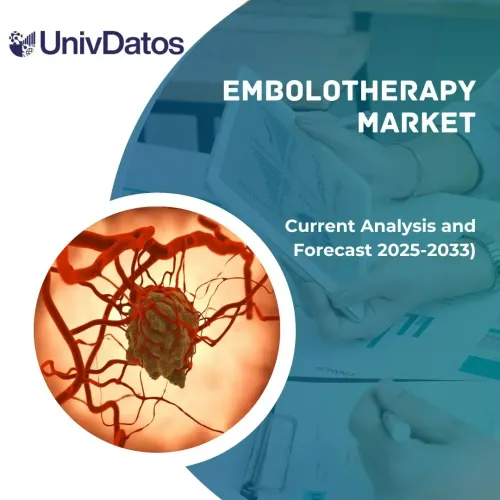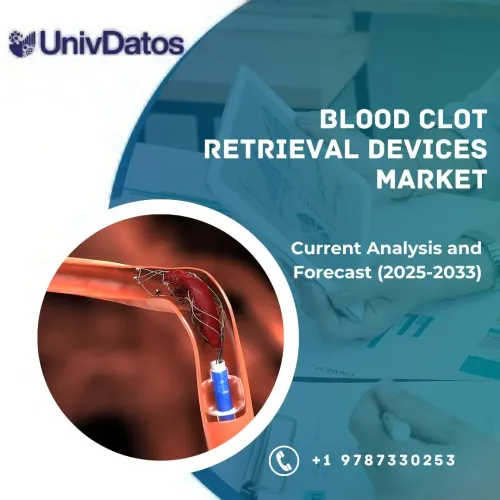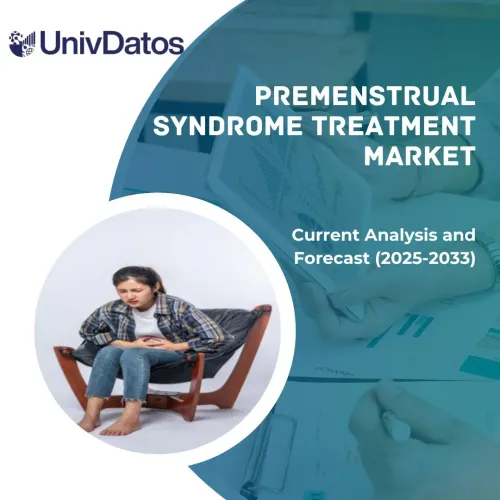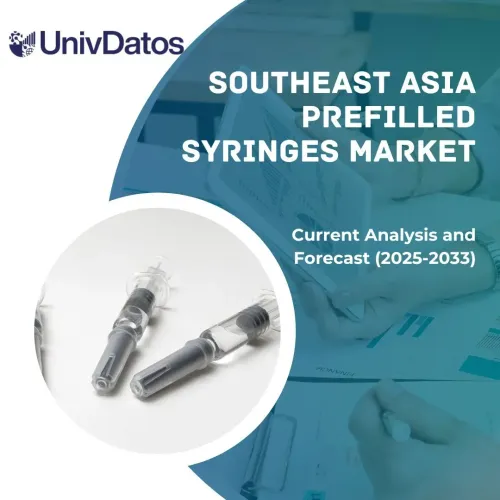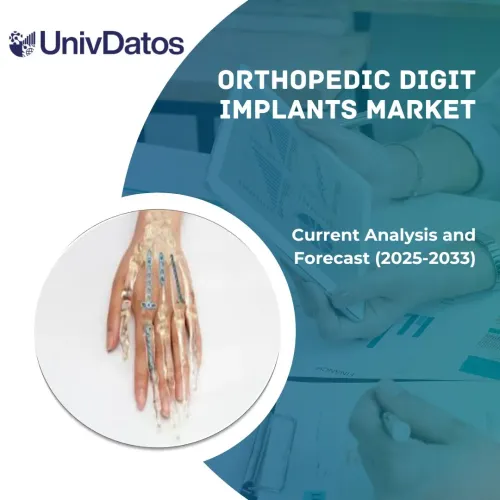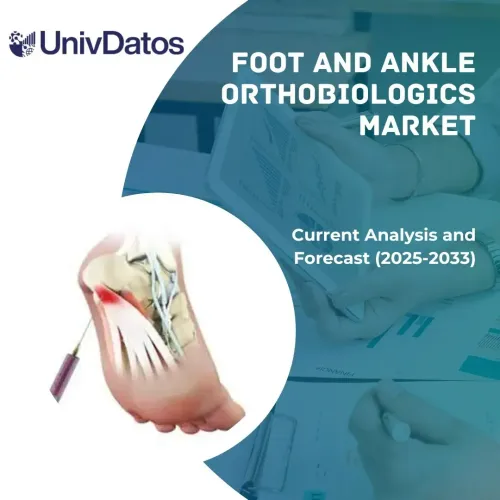- Home
- About Us
- Industry
- Services
- Reading
- Contact Us
Patient Temperature Management Market: Current Analysis and Forecast (2021-2027)
Emphasis on Product (Patient Warming System and Patient Cooling System); Application (Surgery, Neurology, Cardiology, Pediatrics, Orthopedic Surgery, and Others); End-Users (Operating Room, Neonatal ICU, Emergency Room, ICUs, and Others); Region/Country

The global patient temperature management market is anticipated to grow with an elevated CAGR of around 7% over the forecast period (2021-2027). The increasing volume of surgical procedures is one of the key factors impacting the growth of the patient temperature management market. A large number of surgical procedures are being performed globally. Estimates from the Texas Heart Institute indicate over 500,000 coronary bypass procedures are performed each year. Administration of local or general anesthesia to patients before any surgical procedure results in decreased body temperature. Under these circumstances, warming systems are essential to avoid any further intraoperative hypothermia. Adoption of these systems further assists in minimizing the pre- and post-surgical complications and associated discomfort to the patient. Therefore, there is a growing need for modern temperature management systems along with rising demand for conventional warming and cooling devices.
Stryker Corporation, Medtronic Plc, ZOLL Medical Corporation, Bard Medical, Inc., Cincinnati Sub-Zero Products, LLC, 3M Company, Smiths Medical, Inc., Geratherm Medical AG, The Surgical Company, and Atom Medical Corporation are some of the prominent players operating in the patient temperature management market. Several M&As along with partnerships have been undertaken by these players to facilitate customers with the new and advanced medical system.
Insights Presented in the Report
“Amongst product, patient warming systems segment holds the significant share”
Based on product, the market has been distributed into, patient warming system and patient cooling system. In which patient warming systems owe a significant share in the market in 2021. The frequent usage during surgeries during the use of general anesthesia. General anesthesia provided before surgery lowers the patient’s body temperature. Hence, pre-warming of the patient’s body before surgery is required, thereby, reducing the risk of perioperative hypothermia. For instance, 3M Company introduced the 3M Bair Paws Warming Unit with 3M Bair Paws Warming Gown. A rising number of surgeries are undertaken, amid the growing prevalence of cardiac arrest and other chronic cardiac diseases. Hence, this raises the need for patient temperature management, in order to avoid adverse effects on the brain. For more effective results, patient warming systems are also used for cancer patients as adjuncts to chemotherapy and radiation therapy. As a result, the aforementioned factors are contributing to the high demand for patient warming systems.
“Amongst application, surgery segment accounted for a significant share”
Based on the application, the market is categorized into, surgery, neurology, cardiology, pediatrics, orthopedic surgery, and others. Among these, the surgery segment dominated the market and is expected to expand at a prominent CAGR over the forecast period. The increasing number of cardiac and gynecological surgeries across the globe is one of the key attributable factors. Temperature management systems are also largely used in pre-, post-, and perioperative surgical procedures. In addition, these devices help address surgical site complications. In addition, expanding geriatric population, growing awareness about healthcare and rising healthcare spending will also push the market further as a greater number of surgeries would be performed. According to The Heart Foundation, in the U.S. every year around 720,000 people suffer from a heart attack. Cardiac diseases, such as stroke and heart attack need cold temperatures for eliminating any risk of traumatic brain injuries, thereby, generating high demand for cooling devices in the country.
“North America represents one of the largest markets in patient temperature management market”
For a better understanding of the market dynamics of the patient temperature management market, a detailed analysis was conducted for different regions across the globe including North America (the U.S, Canada, and the Rest of North America), Europe (Germany, France, Spain, the United Kingdom, Italy, and Rest of Europe), Asia-Pacific (China, India, Japan, South Korea, and Rest of Asia-pacific) and Rest of World has been conducted. North America constitutes a major market for the patient temperature management market industry in 2020 owing to the presence of well-established market players in the region, a large and growing population, and frequent product launches.
Reasons to buy this report:
- The study includes market sizing and forecasting analysis validated by authenticated key industry experts
- The report presents a quick review of overall industry performance at one glance
- The report covers an in-depth analysis of prominent industry peers with a primary focus on key business financials, product portfolio, expansion strategies, and recent developments
- Detailed examination of drivers, restraints, key trends, and opportunities prevailing in the industry
- The study comprehensively covers the market across different segments
- Deep dive regional level analysis of the industry
Customization Options:
The global patient temperature management market can further be customized as per the requirement or any other market segment. Besides this, UMI understands that you may have your own business needs, hence feel free to connect with us to get a report that completely suits your requirements.
Table of Content
Research Methodology for the Global Patient Temperature Management Market Analysis (2021-2027)
Analyzing the historical market, estimating the current market, and forecasting the future market of the global patient temperature management market were the three major steps undertaken to create and analyze the adoption of patient temperature management in major regions globally. Exhaustive secondary research was conducted to collect the historical market numbers and estimate the current market size. Secondly, to validate these insights, numerous findings and assumptions were taken into consideration. Moreover, exhaustive primary interviews were also conducted, with industry experts across the value chain of the global patient temperature management market. Post assumption and validation of market numbers through primary interviews, we employed a top-down/bottom-up approach to forecasting the complete market size. Thereafter, market breakdown and data triangulation methods were adopted to estimate and analyze the market size of segments and sub-segments of the industry pertains to. Detailed methodology is explained below:
Seek More Details About Research Methodology
Analysis of Historical Market Size
Step 1: In-Depth Study of Secondary Sources:
Detail secondary study was conducted to obtain the historical market size of patient temperature management through company internal sources such as annual reports & financial statements, performance presentations, press releases, etc., and external sources including journals, news & articles, government publications, competitor publications, sector reports, third-party database, and other credible publications.
Step 2: Market Segmentation:
After obtaining the historical market size of the patient temperature management market, we conducted a detailed secondary analysis to gather historical market insights and share for different segments & sub-segments for major regions. Major segments included in the report as product, application, and end-users. Further country-level analyses were conducted to evaluate the overall adoption of Patient Temperature Management across the globe.
Step 3: Factor Analysis:
After acquiring the historical market size of different segments and sub-segments, we conducted a detailed factor analysis was conducted using dependent and independent variables such as technological advancement in the healthcare sector and growing demand for improved medical treatment. Historical trends and their year-on-year impact on the market size and share in the recent past were analyzed. The demand and supply-side scenarios were also thoroughly studied.
Current Market Size Estimate & Forecast
Current Market Sizing: Based on actionable insights from the above 3 steps, we arrived at the current market size, key players in the Patient Temperature Management market, and market shares of the segments. All the required percentage shares split, and market breakdowns were determined using the above-mentioned secondary approach and were verified through primary interviews.
Estimation & Forecasting: For market estimation and forecast, weights were assigned to different factors including drivers & trends, restraints, and opportunities available for the stakeholders. After analyzing these factors, relevant forecasting techniques i.e., the top-down/bottom-up approach were applied to arrive at the market forecast for 2027 for different segments and subsegments across the major markets globally. The research methodology adopted to estimate the market size encompasses:
- The industry’s market size, in terms of value (US$) and the adoption rate of patient temperature management across the major markets domestically
- All percentage shares, splits, and breakdowns of market segments and sub-segments
- Key players in the Patient Temperature Management market in terms of products offered. Also, the growth strategies adopted by these players to compete in the fast-growing market
Market Size and Share Validation
Primary Research: In-depth interviews were conducted with the Key Opinion Leaders (KOLs) including Top Level Executives (CXO/VPs, Sales Head, Marketing Head, Operational Head, Regional Head, Country Head, etc.) across major regions. Primary research findings were then summarized, and statistical analysis was performed to prove the stated hypothesis. Inputs from primary research were consolidated with secondary findings, hence turning information into actionable insights.
Split of Primary Participants in Different Regions
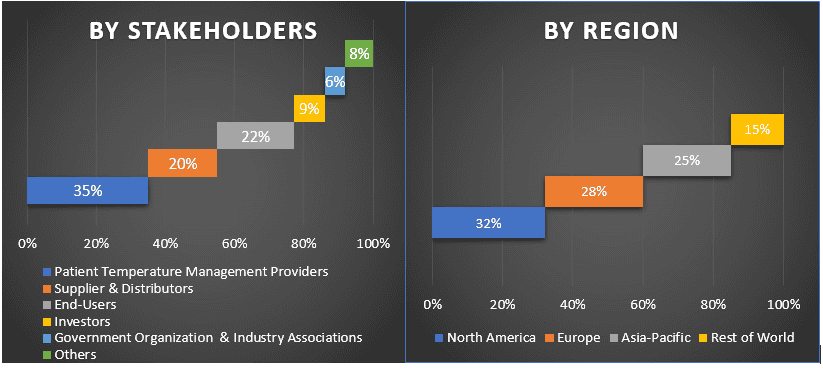
Market Engineering
The data triangulation technique was employed to complete the overall market estimation and to arrive at precise statistical numbers for each segment and sub-segment of the patient temperature management market. Data was split into several segments & sub-segments post studying various parameters and trends in the areas of product, application, and end-users of the patient temperature management market.
The main objective of the patient temperature management market study
The current & future market trends of patient temperature management were pinpointed in the study. Investors can gain strategic insights to base their discretion for investments on the qualitative and quantitative analysis performed in the study. Current and future market trends determined the overall attractiveness of the market at a regional level, providing a platform for the industrial participant to exploit the untapped market to benefit from a first-mover advantage. Other quantitative goals of the studies include:
- Analyze the current and forecast market size of patient temperature management in terms of value (USD). Also, analyze the current and forecast market size of different segments and sub-segments
- Segments in the study include areas of product, application, and end-users
- Define and analysis of the regulatory framework for the patient temperature management industry
- Analyze the value chain involved with the presence of various intermediaries, along with analyzing customer and competitor behaviors of the industry
- Analyze the current and forecast market size of the patient temperature management market for the major region
- Major regions studied in the report include North America, Europe, Asia-Pacific, and the Rest of the world
- Company profiles of the patient temperature management market and the growth strategies adopted by the market players to sustain in the fast-growing market
Deep dive regional level analysis of the industry
Related Reports
Customers who bought this item also bought



